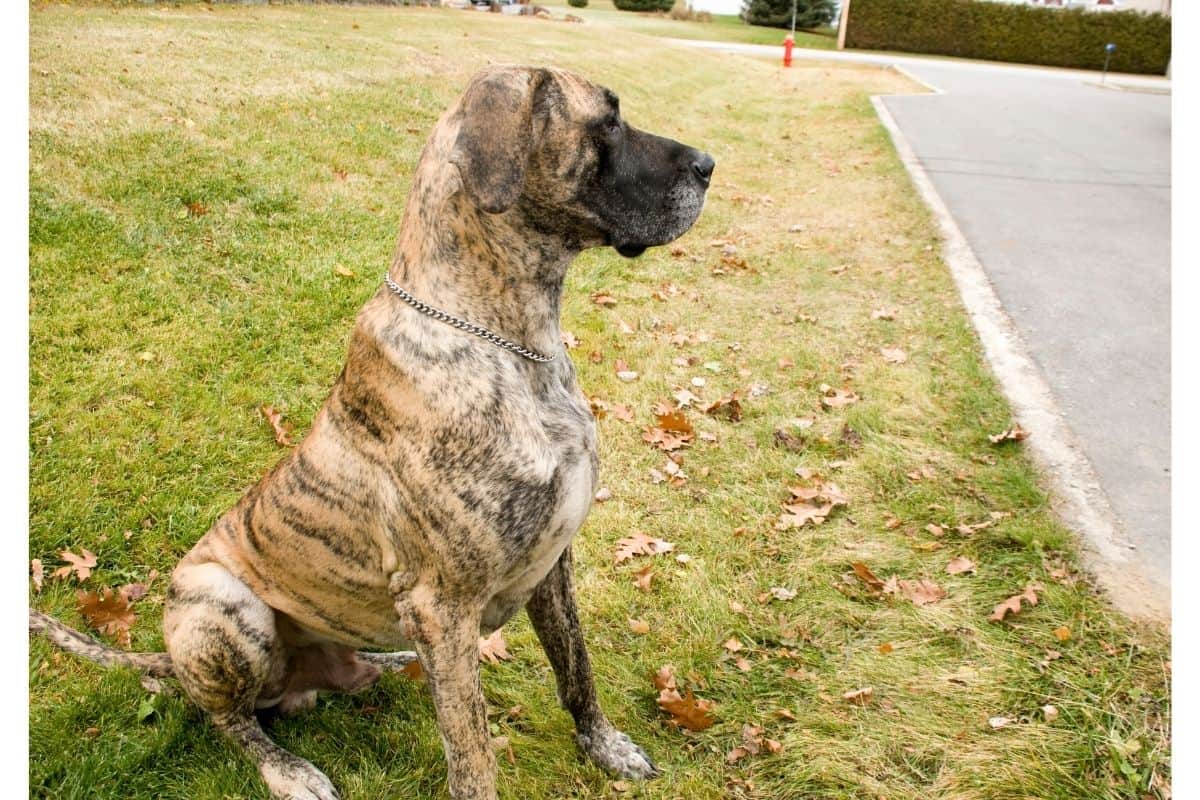
While many people may think of them as “tiger stripes”, brindle is actually one of the seven official Great Dane coat colors! This coat can also be seen in other dog breeds such as greyhounds, boxers, pit bulls, and akitas.
With that in mind, let’s take a deeper look to learn more specifically about brindle Great Danes!
AKC Standard for Brindle Great Danes
Although brindle is one of the official breed colors, its description is surprisingly technical!
The AKC standard for brindle Great Danes is described as follows:
- The base color shall be yellow gold and always be brindled with black cross stripes.
- Brindle shall have a black chevron pattern with a black mask. Black should appear on the eye rims and eyebrows and may appear on the ears and tail tip.
- The more intense the base color and the more distinct and evenly brindled, the more preferred will be the color. Too much or too little brindling is equally undesirable. White markings on the chest or toes; black fronted; dirty colored Brindles; are not desirable.
Let’s break that down into layman’s terms!
The first point is simply saying that the base coat color is yellow gold distinct black stripes across the body.
Point number two indicates that black should not only be on the face (muzzle), but also around the eyes, ears, and tail. Preference is shown for brindle coats that have more contrast between the stripes and base coat, as well as where the stripes are even across the body.
Lastly, point number three further clarifies that there need to be enough stripes to emphasize the pattern without overdoing it. The emphasis on “even” brindling is because the consistency creates a pleasing visual instead of having more stripes towards the front or back which could create an unpleasing optical illusion.
The pattern should also not be interrupted by light patches of fur on the chest of toes because it is most pleasing to the eye when the pattern is consistent.
Given that these are the breed standards for an “ideal” Great Dane, it’s clear that not every dog will meet these exact criteria. Just like humans, there is simply variation from dog to dog!
This is not to say that there is anything “wrong” with a brindle Great Dane who does not perfectly meet these specifications. It just means that they would lose points in a show from a scoring standpoint.
Aside from losing points in a show, these visual deviations do not lower their value in any way to you as a companion and member of your family!
You may also come across other variations of the brindle coat as well including:
- Brindle mantle
- Blue brindle
- Blue brindle mantle
- Brindle merle
- Brindle merle mantle
- Blue brindle merle
- Blue brindle merle mantle
- Brindle harlequin
- Brindle harlequin mantle
- Blue brindle harlequin mantle
While none of these versions are show-acceptable, they are very likely still fantastic dogs for the non-showing family.
Are Brindle Great Danes Rare?
Brindle Great Danes are not considered to be truly rare given that they are one of the breed’s seven official colors.
However, because the alleles for the brindle markings are on the K locus, they can be more difficult to produce than other colors. For example, the K locus also contains the black dominant allele, for which if one is present the dog will present as black rather than brindle.
Producing a brindle dog requires that neither parent passes along the dominant black allele to ensure that it does not override the recessive brindle allele.
For this reason, it is once again more difficult to produce brindles than other colors, but with careful planning, it is still easily accomplished.

How Much Do Brindle Great Danes Cost?
The cost of a purebred brindle Great Dane falls in line with other colors and is typically in the range of $1,700 – $3,000. Dogs from champion lines that are sold as show dogs will be on the higher end of that range, and potentially more.
In my experience, not many breeders are breeding specifically for brindles as might be seen with blacks or blues. The litter resulting from brindles often leads to a large number of puppies with markings that are not showable, therefore making them more difficult to sell.
This is not to say that there is anything else wrong with these non-showable puppies, just that it creates a smaller pool of potential buyers for a breeder and is therefore less desirable.
For this reason, the cost of brindle puppies is often in line with that of other colors and is not elevated due to its “rarity”.
Brindle Great Dane Considerations
Unlike white Great Danes, there are no additional health considerations to take into account with a brindle Great Dane.
You will still have to keep an eye out for common Great Dane health issues such as bloat, cancer, Wobblers syndrome, and hip dysplasia, but these, unfortunately, can affect any dog.
If you found this article helpful, make sure to take a look at my other related posts linked below!
